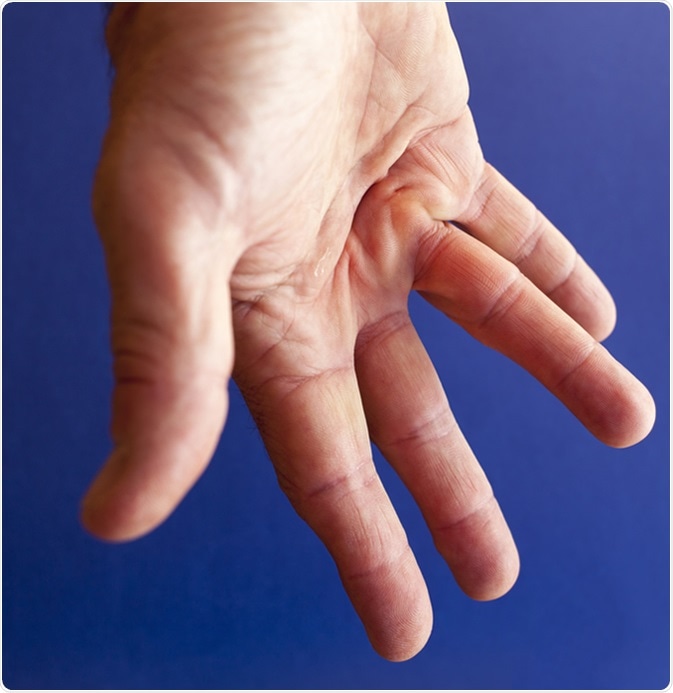Dupuytren's contracture, also known as Dupuytren's disease, occurs when it is difficult for someone to fully extend their finger because the movement is limited by cords of shortened connective tissue.
Dupuytren's contracture is not a life-threatening condition, and the nodules are not cancerous. However, what happens over time can be discomforting. Eventually, the lumps, or nodules, may grow into cords of cells or tissue. If these strings of tissue have grown along a finger or thumb, they may pull it and bend it toward the center or palm of a hand.

Hand of an man with Dupuytren contracture disease. Image Credit: Fineart1 / Shutterstock
Researchers have not yet been able to determine what causes the condition, but some indicate that the disease may be tied to genetics. Approximately 4 to 7 of every 10 people who have Dupuytren’s also have a family history of the disease.
For many who have the condition, some family members also have the disease. For this reason, some believe that Dupuytren’s is an autosomal dominant disorder that is inherited. The abnormal gene only has to be inherited from one parent for someone to have the disease. That parent also may have the condition. Another reason to believe Dupuytren’s is genetic: It often appears in people of northern European descent.
However, to be clear, there may be other possible causes for this, including:
- Diabetes, possibly due to high levels of blood sugar;
- Antiepileptic drugs used to treat epilepsy;
- Smoking;
- Excessive use of alcohol.
Yet, many who have Dupuytren’s disease do not have these issues. Some research indicates that any correlations between these conditions and Dupuytren’s are not significant.
Some also believe that previous hand trauma may increase the chance for Dupuytren’s to occur, but such a link to the condition is not clear. Some investigations have indicated that a connection exists between Dupuytren's contracture and manual labor.
Gene Modifications
Some researchers indicate that modifications occurring in certain genes influence the potential for the onset of Dupuytren’s. The Wnt signaling pathway comes into play, affecting some of these genes. The pathway regulates how cells grow and divide. It helps determine a cell’s specific functionality.
An unusual increase in the number of connective tissue cells is key in how Dupuytren’s disease evolves. The deep fibrous tissue in the hand of those who have this condition has a large number of connective tissue cells which have myofibril protein strands. Myofibrils are the basis of muscle fibers, and help them decrease in size. But the greater number of these fibroblasts in Dupuytren’s facilitates the unusual shortening of fibrous tissue and yields large amounts of type III collagen tissue protein.
The unusual contraction and extra amount of collagen combine to cause the shortening and thickening of fibrous tissue that occurs with Dupuytren’s. Yet, scientists have not been able to make a connection as to how modifications in genes that affect the Wnt signaling pathway may be related to how the condition comes about.
However, other research relates to transforming growth factor beta one (TGF beta 1), a multifunctional cytokine that significantly influences connective tissue and how wounds heal. TGF beta 1 increases the number of fibroblasts and impacts the extracellular matrix. Earlier research established a relationship between TGF beta 1 and Dupuytren’s. It may involve a gene that makes one susceptible to the disease.
Yet some observers think that common TGF beta 1 polymorphisms do not have a link to the onset of Dupuytren’s. But their data may require a cautious interpretation because of the lack of a relationship was established in only one series of patients. More in depth research may paint a different picture and establish a correlation.
Further Reading